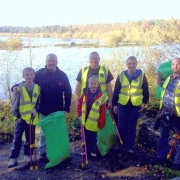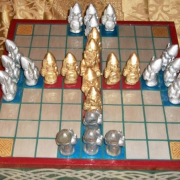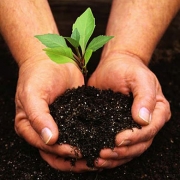An Old Heritage
By Garry Leak, AOR
Canada is a Nation of immigrants. Even our indigenous aboriginal Native population is considered to have come from elsewhere. Eirik the Red Thorvaldsson having been kicked out of Norway emigrated to Iceland. From there it was a short sail to Greenland, a misnomer if ever there was one, and from there another short sail to Canada. Vinland, they called it, and that has been a problem ever since. Vinland as they found it didn’t grow grapes, anymore than Greenland was green.
L’Anse au Meadows was a Norse settlement on the northern tip of Newfoundland that flourished for a number of years. You can visit a rebuilt version of it today; it is a world heritage site. There were women, and children, and they also had the ability to smelt iron. Unfortunately they did not get on very well with the local Native population, and while there are stories of the heroism of some of me women who defended hearth and home in the absence of their men folk against what they called the Skraelings, they ultimately gave up, and left.
Christopher Columbus, and his kin came with guns, armour, and Christian priests, and were successful in their ethnic cleansing.
More recent population movement to Canada has seen an influx of people from all over the world, and as long as they don’t bring the problems of their homeland with them, and are willing to work, and start a new life, they are welcome. Iceland is a small island. The overflow of its population came to Canada, and settled in the Province of Manitoba at a place they called Gimli. In fact there were so many of them that they were granted a large tract of land, and allowed to name themselves the Republic of Iceland, an independent Republic within Canada. They settled around lake Winnipeg, which is a huge inland fresh water lake, and fished and farmed. Icelanders are good at fishing and farming, but even so they suffered great hardship in an unforgiving land with a harsh winter. Eventually they joined the confederation of Canada, were absorbed into our culture, and political structure.
Other Icelanders settled in Ontario, which is a little gentler in climate, and has fertile land suitable for general farming. Some of these people built a community that they called Kinmount. To this day, Kinmount remembers its Icelandic Heritage. Every year they hold a fair with agricultural-type exhibitions and competitions, and a parade. Last year the theme of the parade was ‘Vikings’; what else?
The men wore plastic “Viking” style helmets with horns, and some of the ladies wore traditional Icelandic dress of basic black with white lace trimmings. A few of the men got themselves rigged out in some serious armour with swords, chain mail, and helmets.
The parade was made up of local farmers with their tractors, local shopkeepers with their vans, the local fire engine, and the local police car with sirens wailing. The ice hockey team skated past on roller blades, and the daughters of the town paraded past as drum majorettes.
Our group, dressed as ‘Vikings’, waved our swords in the air, and yelled at the spectators lining the road that if it hadn’t been for Leif Eiriksson they wouldn’t be there. They didn’t seem to know what we were yelling about, but cheered us on anyway. One woman shouted at us asking if we’d come to pillage and rape, so we gave her a cheer.
We even had a genuine Icelandic horse, which behaved very well. Its rider wore a pair of horns that would have made a Texas long horn jealous. I am not of Icelandic origin, though I might share a few genes with them because my family originate in the north east of England. I was invited to participate anyway.
Afterwards we commandeered some picnic tables, and had a good feast, which included a bottle of homemade mead that I’d smuggled in. Small town Ontario still has a few archaic by-laws about drinking in public, so we decided to be circumspect, and not spoil an exciting day by having to fight the law.
This was a celebration of what we are and how we live. It was not a demonstration. The people who participated in this parade were doing no more than celebrate their cultural Heritage, and the fact that they are free to express it in a pleasurable way. It is important to celebrate our cultural Heritage, because if we don’t we will lose it. It is also important to enjoy the celebration, because otherwise the parade becomes a procession, and that’s what the Christians do in such a joyless manner.
Finally, a short word on the reality of our Religion and its place in the world of today. It is great fun to dress up, and make a play of a by-gone era. However, within the Religious context we must always remember that our Gods and Goddesses are of, and with, today. They are not an anachronism, anymore than we are.
Our forebears had to work with horses, and some horses were held sacred. We don’t work with horses anymore. We travel with cars, lorries, and planes. We don’t farm our food, or cut wood to warm ourselves in winter. We exchange our energy for a mobile type of energy called money, which in turn we exchange for food, heat, and clothes, as well as petrol.
It is natural to hanker after yesterday, but the reality of yesterday is that it was a brutal, short-lived existence, which very few of us would want to endure. Consider then the place of our Gods and Goddesses today. They are in the supermarket, the motorway, and the workplace, as well as the glorious countryside, the woods, and the deserts, and mountains. In fact they are everywhere!
Are they with you in all of these places? They are, because they are as relevant, and as alive to us today as they were to our ancestors. I doubt that you’ll find them riding horses down a motorway, however. Maybe the Sleipnir of today is more likely to have eight cylinders than eight legs!





Leave a Reply
Want to join the discussion?Feel free to contribute!